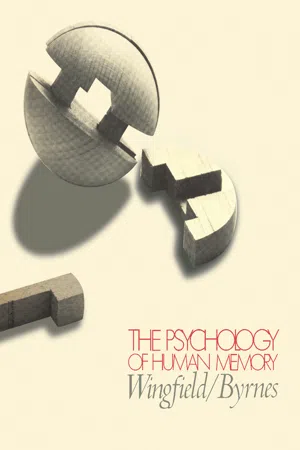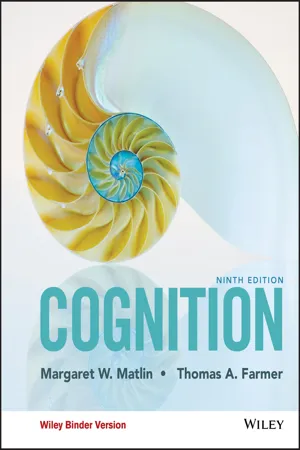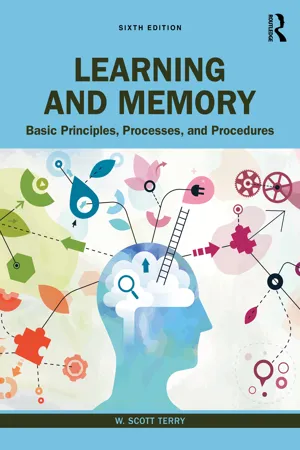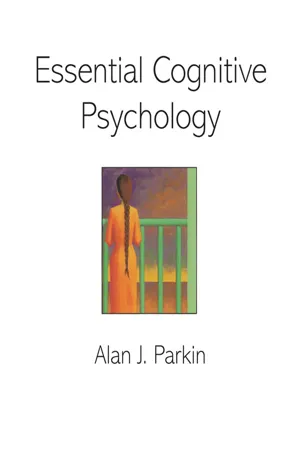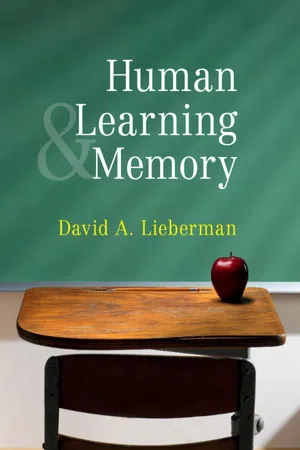Psychology
Short-Term Memory
Short-term memory refers to the temporary storage of information in the brain for immediate use. It has a limited capacity and duration, typically holding around 7 items for about 20-30 seconds. Short-term memory is crucial for tasks like remembering a phone number long enough to dial it or recalling a recent conversation.
Written by Perlego with AI-assistance
Related key terms
1 of 5
10 Key excerpts on "Short-Term Memory"
- eBook - ePub
- Jay Lampert(Author)
- 2023(Publication Date)
- Bloomsbury Academic(Publisher)
There must be short term retentions that make experience feel continuous from one moment to the next, as well as some long term storage of a knowledge base. When we listen to a person talking, for example, we have to retain the beginning of a heard word while we hear the end of it, and we have to know the meaning of the words, which we will have learned a long time ago. This kind of example leads Roman Jakobson to say that, “the role of short- and long-term memory constitutes one of the central problems of both general linguistics and the psychology of language.” 2 The literature in cognitive psychology on short term memory is complicated and disputed. I will draw from two frequently cited survey articles: Nelson Cowan’s “What are the differences between long-term, short-term, and working memory?” in Progress in Brain Research, 2008 ; 3 and Bart Aben et al., “About the Distinction between Working Memory and Short-Term Memory” in Frontiers in Psychology, 2012. 4 The conceptual speculations below about the meaning of the short term are my own. Short term memory is memory for a particular experienced image retained (again, in what Husserl calls secondary retention) only for a short amount of time, or to be more operationally precise, memory that can only be recalled a short amount of time later. One might think that short term memory is memory that simply lasts a shorter amount of time than long term memory. But we will see that most theorists of memory think of “memory” as an equivocal term, naming two different functions (not including “primary retention”) that may be performed on an original experience, one of which leads to its short term retention, and one of which leads to its long term retention. Short and long term memory thus tend to be defined primarily by the operations they perform on the original experience, and only secondarily by the length of time the original experience lasts - eBook - PDF
- Arthur Wingfield, Dennis L. Byrnes(Authors)
- 2013(Publication Date)
- Academic Press(Publisher)
These characteristics are commonly referred to as those of Short-Term Memory, a transient working memory for temporarily holding infor-mation for immediate use. This type of memory, in other words, is limited in storage capacity and duration. If we rehearse or think about the material sufficiently, it may become part of our enduring long-term memory. This happens for numbers we dial frequently, or ones like our own, which we constantly give to friends or write on endless school or business forms. Those materials we do not think about or rehearse, on Approaches Jo Short-Term Memory 239 the other hand, seem never to survive beyond this transient form of memory. Our goal in this chapter is to take a close look at this so-called kk Short-Term Memory. APPROACHES TO Short-Term Memory To many psychologists, most notably Donald Broadbent (1958), the idea of a separate working memory within the total memory system seemed to have a certain adaptive quality about it. Just imagine what it would be like if we added dozens of numbers in the course of some mathematics exercise and in so doing found that we had formed a permanent memory of each and every number used in the calculation. The result would be mental chaos! There are some cases, in other words, where too good a memory would be maladaptive. For these and other reasons, the distinction between the transient, short-term storage of information versus long-term semantic storage became an active topic of research and speculation within experimental psychology. Indeed, the term k k Short-Term Memory gained sufficient familiarity that the simple abbreviation, STM, seemed to take on a meaning of its own. The temporary storage and use of information began to be seen as an identifiably separate function within the total memory system, and with this view, the topic of Short-Term Memory became a distinct research enterprise. - eBook - PDF
The Psychology of Ageing
From Mind to Society
- Gary Christopher(Author)
- 2017(Publication Date)
- Red Globe Press(Publisher)
58 C HAPTER 4 Short-Term Memory A great deal of research focuses on problems with long-term memory – our ability, in other words, to access a lifetime’s acquired knowledge, to recall important events in our lives, and so on. Before tackling this, however, it is important to explore how Short-Term Memory is affected. For the purpose of this chapter the models of working memory will be used primarily to explore the type of problems associated with normal ageing. Working memory may be conceptualized as dealing with the manipulation, integration, and short-term storage of information. The previous chapter on basic cognitive pro-cesses is important here. Without such mechanisms active working memory operations would suffer greatly. We need effective sensory systems and intact attentional control mechanisms for working memory to operate effectively. At the end of this chapter I shall focus a little more on the frontal lobes. This region of the brain is intimately involved in many working memory activities and is central to all higher-order executive functions. It is key also in terms of our ability to function successfully in everyday life (see Chapter 7). The final section will focus on some recent research that has examined executive func-tion in older adults using neuroimaging technology. Working memory To begin with, then, it is important to consider what we mean by Short-Term Memory. When talking about Short-Term Memory we are referring to discrete cognitive systems that have limited storage capacity – limited both in terms of how much is stored and how long it is stored for. Early pioneers of cogni-tive research demonstrated that the capacity of Short-Term Memory is finite. The most elegantly simple demonstration of this was presented in the classic paper by Miller (1956) ‘The Magical Number Seven, Plus or Minus Two: Some Limits on Our Capacity for Processing Information’. It was clear also that there is a time limitation to storing such material. Unless appropriate - eBook - PDF
- Margaret W. Matlin, Thomas A. Farmer(Authors)
- 2016(Publication Date)
- Wiley(Publisher)
We conclude by examining how the principles that govern long-term memory can be applied to increase our understanding of real-world issues. CHAPTER INTRODUCTION BRIEF OVERVIEW OF LONG-TERM MEMORY As noted in previous chapters, psychologists often divide memory into two basic cat- egories: working memory (the brief, immediate memory for material we are currently processing) and long-term memory. Chapter 4 emphasized two main features of work- ing memory: (1) working memory is fragile—the information that you want to retain can disappear from memory after less than a minute, and (2) the capacity of working memory is limited—you can only simultaneously process and store so much informa- tion at one point in time. In contrast, your long-term memory is very high capacity and Brief Overview of Long-Term Memory 145 can retain material for many decades. Long-term memory refers to the high-capacity storage system that contains your memories for experiences and information that you have accumulated throughout your lifetime. Information in long-term memory can last for a few minutes to many decades. For example, Bahrick and colleagues (1975) found that people were 90% correct at recognizing their high school classmates’ pictures and names, taken from their high school yearbooks, even 15 years after graduation! Traditionally, information is said to be stored in your long-term memory if it is not lost or otherwise discarded by your working memory systems. Like many psy- chologists, however, I’m not irmly convinced that working memory and long-term memory are two distinctly different kinds of memory. I do believe, however, that the division is a convenient way to partition the enormous amount of existing research and scientiic knowledge about our memory processes. Psychologists often subdivide long-term memory into more speciic categories. - eBook - PDF
- P.A. Hancock(Author)
- 1987(Publication Date)
- North Holland(Publisher)
The central theme of this analysis was that the durability of memory depends on how the material was processed when it was received. Rather than characterizing memory as falling into one of two discrete categories, short-term and long-term, duration was viewed as a continuous function of the extent to which the material was made meaningful during its presentation. However, this analysis did not deny the distinction between primary memory (material currently in consciousness) and secondary memory (material which has left current awareness but which can be retrieved), as a close reading will show (Craik 8c Lockhart, 1972, p. 676). That distinction, originating with William James (James, 1890; Norman, 1976, p. 84), seems valid on intuitive grounds and has not been seriously questioned. Short - Term Memory 3 It is not clear how to classify the notion of Short-Term Memory as it applies to keeping track of information in our truck dispatcher example. Perhaps this is primary memory in the sense used by William James, or perhaps it is material which has not been deeply processed in the Craik and Lockhart sense. The present analysis is neutral regarding these theoretical positions, and uses terms like immediate memory, Short-Term Memory (STM), and working memory interchangeably. 1.2. DISTRACTION Our hypothetical truck dispatcher was faced with two types of problems - loss of STM due to distraction, and the need to retain more information than the capacity of STM allows. This section discusses the distraction problem. 1.2.1. The Brown-Peterson Effect The role of distraction in causing loss in STM was demonstrated almost simultaneously by Brown (1 958) in England and by Peterson and Peterson (1959) in the United States, and the result has become known as the Brown-Peterson effect. In the typical demonstration people are asked to retain three or four letters for 20 seconds while simultaneously counting backwards by threes during the retention interval. - eBook - ePub
Learning and Memory
Basic Principles, Processes, and Procedures
- W. Scott Terry(Author)
- 2023(Publication Date)
- Routledge(Publisher)
Zola-Morgan & Squire, 1993 ). Neuroscientists are delineating brain areas that are active during short-term retention, and which are separate from those involved in LTM. Finally, the concept of STM has provided valuable insights into learning and memory in general. Any single experiment or observation does not prove the existence of separate memory systems. A familiar phrase attributed to the psychologist Kurt Lewin is, “There’s nothing so practical as a good theory.”As has been noted frequently, memory is not a single thing. The alternative ways of partitioning memory often cause confusion in comparing one theory to another. Box 8.3 addresses some alternative senses of “Short-Term Memory.”Box 8.3 Short-Term Memory, Working Memory, Executive Function: What’s the Difference?
I often hear people refer to any forgetting of recent events as a Short-Term Memory problem. What they are usually referring to, however, is forgetting that takes place over hours or days. Technically this is not STM or working memory as discussed in this chapter. These forgettings could be described as problems with recent memory, which is a nontechnical term, but possibly should be added to describe everyday lapses than encompass recent events.Short-Term Memory is the verbal rehearsal buffer. It is usually tested with the distractor task or the memory span task, to measure the retention of strings of three to seven digits, letters, or words.Working memory is an expansion of STM. WM includes a verbal store; a visuospatial store; and control processes to select and allocate resources. WM is assessed with a dual-task that requires doing two things simultaneously, such as remembering visual and verbal items, or remembering and mental problem solving.Executive function is an elaboration of Baddeley’s central executive. The core functions of the central executive are: focusing attention on a relevant task; resisting distraction from irrelevant stimuli; retaining information in working memory; inhibiting responses; and flexibly shifting strategies.The phrase executive functions - eBook - PDF
Studying at University
How to be a Successful Student
- David McIlroy(Author)
- 2003(Publication Date)
- SAGE Publications Ltd(Publisher)
8 KEY CONCEPTS l l l l l l l l l l l l l l l l l l Your memory may be better than you think Short term and long term memory It appears that some of the information evaporates at the short-term stage and other aspects are transferred to more abiding storage (long-term memory). Although this is an oversimplification of memory structure and function (Baddeley, 1999), it illustrates the point that some memories are readily retrieved and some appear to go AWOL. Many people underestimate the power of their own memory, perhaps partly because they chiefly access their Short-Term Memory (now more commonly referred to as ‘working memory’), or have not used good memory techniques or have not suffi-ciently focused on the large volume of information that they do remember. The human brain has an enormous capacity for remembering, and some understanding of storage and retrieval procedures will help improve memory use. There are some memories that we do not have to try to retrieve because they just spring into our conscious mind without solicitation. It is possible that these memories were important to us or we were especially interested in their content or that they were just catchy and humorous such as the following limerick: There once was a man from Trinity, who thought he’d cracked the square root for infinity; but there were so many digits, it gave him the fidgets, so he dropped it and studied divinity. Many years ago a speaker used this to illustrate the point that perhaps some people study theology because they would fail at everything else! Because there is rhyme, humour, a moral and a context, this limerick is remembered effortlessly. You should be encouraged to know that some of the things you study at college/university will stay with you and you will be able to recall them for use whenever you need them. Some years ago a mature first year student went to his tutor for advice about whether he should sit his exams. - Lorelle J. Burton, Drew Westen, Robin M. Kowalski(Authors)
- 2022(Publication Date)
- Wiley(Publisher)
Third, the standard model overemphasises conscious memory for relatively neutral facts and under emphasises other forms of remembering, such as skill learning and everyday remembering. Fourth, the underlying metaphor has changed, from mind as computer to mind as brain. 10.2 Working memory LEARNING OUTCOME 10.2 Describe working memory. Because people use STM as a ‘workspace’ to process new information and to call up relevant information from LTM, many psychologists now think of STM as a component of working memory. Working memory refers to the temporary storage and processing of information that can be used to solve problems, respond to environmental demands or achieve goals (see Baddeley, 1992, 1995; Richardson, 1996a, 1996b). Pdf_Folio:458 458 Psychology Working memory is active memory: information remains in working memory only as long as the person consciously processes, examines or manipulates it. Like the older concept of STM, working memory includes both a temporary memory store and a set of strategies, or control processes, for mentally manipulating the information momentarily held in that store. These control processes can be as simple as repeating a phone number over and over until we have finished dialling it — or as complex as trying to solve an equation in our heads. Researchers initially believed that two components of working memory — temporary storage and mental control — competed for the limited space at the lunch counter. In this view, rehearsing information is an active process that itself uses up some of the limited capacity of STM. Researchers also tended to view STM as a single system that could hold a maximum of about seven pieces of information of any kind, whether numbers, words or images. More recent research suggests, instead, that working memory consists of multiple systems and that its storage and processing functions do not compete for limited space.- eBook - ePub
- Alan J. Parkin(Author)
- 2014(Publication Date)
- Psychology Press(Publisher)
Sequences of these different types of string were presented and it was found that the number of errors in sequence repetition decreased systematically as strings closer in their approximation to English were used. This finding reflects the chunking that subjects were able to do, e.g. remembering “ERE” as opposed to “E”, “R”, “E”.The above findings demonstrate that the capacity of short-term store will vary depending on the nature of the information being remembered. This finding illustrates a fundamental problem in attempting to measure human memory capacity. Artificial storage systems such as floppy discs, compact discs, and magnetic tapes, have measurable fixed capacities because information is fed into them in the form of basic information units (e.g. “bytes” of information). In order to measure the capacity of human memory we would first need some similar method for reducing any to-be-remembered information into basic units. This may be possible in the future but, at present, our lack of a basic unit for measuring the size of different pieces of information put into memory precludes any attempt to measure memory capacity accurately.Long-term recencyConsider the following experiment. Subjects are presented with nine pairs of words to learn. Each pair is presented for 2 seconds followed by a period of distracting activity (mental arithmetic). After the last pair there is a further period of distraction before recall of the nine pairs is attempted. In version ‘A’ the period of distraction between each pair is 4 seconds followed by a final distraction period of 12 seconds. In version ‘B’ the period of distraction between each pair is 12 seconds and the final distraction period is 36 seconds. - eBook - PDF
- David A. Lieberman(Author)
- 2011(Publication Date)
- Cambridge University Press(Publisher)
This contrasts with longer-term memories where, once a memory has lasted more than an hour, we typically remember it for days or even years. Moreover, the number of events that we can store also seems very different for recent memories and older ones. For recent memories, research on memory span suggests that we can store only about seven recent events at any one time. Again, this contrasts sharply with our capacity to store older memories, which is vast. Even if we confine our attention simply to vocabulary, most English-speaking adults know about 20,000 words together with their meanings, suggesting that we can store hundreds of thousands of older experiences, against just seven new ones. The Atkinson–Shiffrin model These differences in the properties of older memories and recent ones – in speed of forgetting and in capacity – suggested to a number of psychologists that we may possess two memory stores rather than one. The first, called Short-Term Memory or STM , was assumed to be a temporary storage system that holds material just long enough for it to be processed; the capacity of this temporary store is very small. Once processing in this first store is completed, the coded material would be transferred to a more permanent store called long-term memory , or LTM . Following publication of the Brown and Peterson papers, and one by Miller ( 1956 ) drawing attention to memory span, a number of psychologists proposed theories of memory based on the assumption of two separate stores (for exam-ple, Broadbent, 1958 ; Waugh and Norman, 1965 ). Atkinson and Shiffrin ( 1968 ) were the authors of one of these models, and it explained the existing data so successfully that it soon dominated the field and became known as the modal model . (In statistics, the mode is the most common score in a data set; here, the
Index pages curate the most relevant extracts from our library of academic textbooks. They’ve been created using an in-house natural language model (NLM), each adding context and meaning to key research topics.

